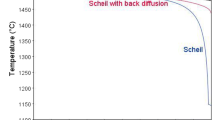Abstract
The solidification path and contraction generated during the solidification of three carbon steels were studied. Two of the carbon steels were of hypo-peritectic chemical composition, with 0.11 % C and 0.15 % C, while one of the carbon steels were hyper-peritectic with 0.16 % C. The steels with 0.11 % C and 0.16 % C solidified as expected due to their chemical composition. In contrast, the chemically hypo-peritectic steel with 0.15 % C solidified as hyper-peritectic steel, which was associated with the microsegregation of Mn. For the steel exhibiting a hypo-peritectic solidification path, peritectic transformation occurred at solid fraction values higher than 0.9, where it was assumed that the contraction generated in the mushy shell cannot be fed by the liquid. However, for steels exhibiting a hyper-peritectic solidification path, peritectic transformation began at solid fraction values lower than 0.9, where the contraction generated by the peritectic transformation was partly fed by the liquid. Hence, the highest cracking susceptibility was associated with the hypo-peritectic solidification mode.
Similar content being viewed by others
References
H. Mizukami, A. Yamanaka, and T. Watanabe, ISIJ Int. 42, 964 (2002).
T. W. Clyne, M. Wolf, and W. Kurz, Metall. Mater. Trans. 13B, 259 (1982).
K. H. Kim, T. J. Yeo, K. H. Oh, and D. N. Lee, ISIJ Int. 36, 284 (1996).
E. T. Turkdogan, Fundamentals of Steelmaking, p. 104, The Institute of Materials, London (1996).
Y. M. Won, T. J. Yeo, D. J. Seol, and K. H. Oh, Metall. Mater. Trans. B 31B, 779 (2000).
J. Konishi, M. Militzer, J. K. Brimacombe, and I. V. Samarasekera, Metall. Mater. Trans. B 33B, 413 (2002).
D. M. Stefanescu, ISIJ Int. 46, 786 (2006).
C. Cicutti and R. Boerl, Steel Res. Int. 77, 194 (2006).
Y. M. Won, H. N. Han, T. J. Yeo, and K. H. Oh, ISIJ Int. 40, 129 (2000).
Y. M. Won and B. G. Thomas, Metall. Mater. Trans. A 32A, 1755 (2001).
W. R. I. A. Perkins, Proc. Int. Conf. organized by The Metals Society, London and L’institut the researches de la sidérurgie francaise (IRSID), and held in Biarritz, France (1976).
J. K. Brimacombe, E. B. Hawbolt and F. Weinberg, Continuous Casting Heat Flow, Solidification and Crack Formation (ed., Bookcrafters ), p. 215, AIME, USA (1984).
H. Shibata, Y. Arai, M. Suzuki, and T. Emi, Metall. Mater. Trans. 31B, 981 (2000).
L. G. Zhu and R. V. Kumar, Ironmak. Steelmak. 34, 71 (2007).
K. H. Kim, K. H. Oh, and D. N. Lee, Script. mater. 34, 301 (1996).
E. Alfaro, M. Herrera, J. J. Ruiz, M. Castro, and H. Solis, ISIJ Int. 49, 851 (2009).
J. Ruiz, M. Herrera, M. Castro, and H. Solis, ISIJ Int. 48, 459 (2008).
J. Miettinen, Scand. J. Metall. 22, 317 (1993).
Y. M. Won, K. H. Kim, T. J. Yeo, and K. H. Oh, ISIJ Int. 38, 1093 (1998).
D. J. Seol, Y. M. Won, K. H. Oh, Y. C. Shin, and C. H. Yim, ISIJ Int. 40, 356 (2000).
A. Thermo-Calc Software AB. The Phase Diagram in Multi-component Alloys, R, Foundation of Computational Thermodynamics, Stockholm, Sweden (2006).
DICTRA Software, A Tool for Simulation of Diffusional Transformations in Alloys, 24, Foundation of Computational Thermodynamics, Stockholm, Sweden, (2006).
S. Louhenkilpi, J. Miettinen, and L. Holappa, ISIJ Int. 46, 914 (2006).
D. Brody and C. Flemings, Trans. Metall. Soc. AIME 236, 615 (1966).
A. Jablonka, K. Harste, and K. Schwerdtfeger, Steel Res. Int. 62, 24 (1991).
Author information
Authors and Affiliations
Corresponding author
Rights and permissions
About this article
Cite this article
Trejo, M.H., Lopez, E.A., Ruiz Mondragon, J.J. et al. Effect of solidification path and contraction on the cracking susceptibility of carbon peritectic steels. Met. Mater. Int. 16, 731–737 (2010). https://doi.org/10.1007/s12540-010-1006-7
Received:
Accepted:
Published:
Issue Date:
DOI: https://doi.org/10.1007/s12540-010-1006-7




